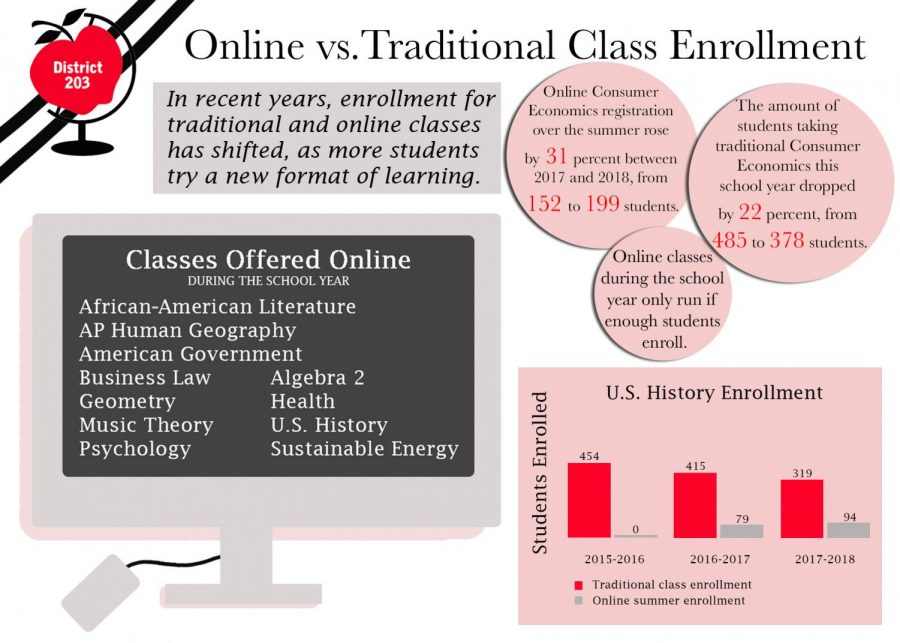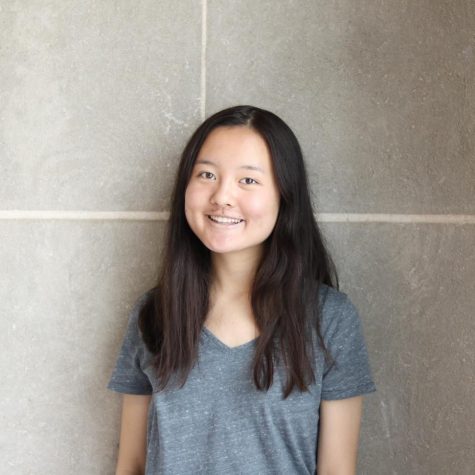Online course registration contributes to significant decrease in enrollment of face-to-face classes
February 26, 2019
The growing popularity of online courses at Naperville Central seems to be contributing to a decline in registration for traditional face-to-face classes.
During the 2015-2016 school year, District 203 began to offer online courses as part of the Expanded Learning Opportunities (eLo) Consortium, along with District 204 and Wheaton District 200. Students also have the opportunity to take online courses from an outside provider, though they have only be able to receive credit for a maximum of two classes.
“We’ve been offering online courses for a few years now,” Director of Student Services Karen Lemanski said. “More and more, we’ve [started to] take ownership of our own courses.”
Through the eLo Consortium, students have the opportunity to take courses that would not otherwise run in school.
“[Game Design] often does run online, because we’re able to use classes put together by students from all three of the districts,” said Carrie McFadden, assistant principal for operations, using the class as an example.
Online courses offered include African-American Literature, Business Law, Algebra 2, Geometry, Health, Music Theory, AP Human Geography, U.S. History, American Government, Psychology and Sustainable Energy, though not all have run each year.
Before students graduate high school, the district wants them “to have at least one experience with an online class so they know how to navigate online learning,” Lemanski said.
Skills honed through online courses extend beyond a student’s high school career.
“We know [that] students are going to be members of an online community when they leave us, whether that is through taking an online class at a college level [or] online training through the workplace,” said Jackie Thornton, assistant principal for curriculum.
Both Thornton and Lemanski emphasized the importance of self-directedness.
“You have to be able to manage your time,” Thornton said.
Naperville Central additionally offers blended classes as an opportunity to receive both face-to-face and online instruction.
“Some of why we implemented blended [learning classes] was because we weren’t having students sign up for online course in large numbers,” Thornton said.
Students may also feel more comfortable taking blended courses before registering for online ones.
“Blended is a nice intermediate step,” Thornton said. “Independent learning days give you the opportunity to grow time management and self advocacy skills in addition to learning how to consume content independently in Canvas.”
While many students choose to take blended classes over the school year, they tend to take online courses over the summer, which may give students space to take another class the following school year.
Consumer Economics, U.S. History and American Government are among the most popular online courses over the summer.
However, because students choose or plan to take these courses over the summer, the amount of students taking the same classes in a face-to-face setting over the school year has dropped.
Registration for U.S. History reflects such a trend. In the 2015-2016 school year, 454 students took the class in a face-to-face setting at school, compared to 415 students in 2016-2017, 350 students in 2017-2018, and 319 students in 2018-2019.
Meanwhile, the amount of students registering for Online U.S. History during the summer has increased. During the summer of 2016, zero students took Online U.S. History, compared to 79 students in 2017 and 94 students in 2018.
A change in school population must be taken into account when considering the decline in registration for face to face classes.
It is the most fitting to compare the junior class size to the amount of students taking U.S. History as a face-to-face class, as students typically take it during their junior year.
There were 753 juniors in 2016-2017, compared to 687 in 2017-2018. However, although 697 juniors attended Naperville Central in the 2018-2019 school year, the amount of students taking U.S. History continued to decrease, suggesting that the trend is not solely caused by class size.
Additionally, the percentage change in student population between the 2016-2017 and 2017-2018 school year was not reflective nor as severe as that of the amount of students taking U.S. History. The 2017-2018 junior class was 2.8 percent smaller than the prior year, while Central experienced a 15.7 percent drop in the amount of students taking U.S. History during the 2017-2018 school year.
A similar pattern may be reflected in course registration numbers for Consumer Economics. Approximately the same amount of students took Consumer Economics in the 2015-2016 and 2016-2017 school year, and the same amount of students took the class online in the the summers of 2016 and 2017.
The amount of students registered for Consumer Economics increased by 10 percent between the 2016-2017 and 2017-2018 school year, from 441 to 485 students. The amount of students taking Online Consumer Economics over the summer rose by 31 percent between 2017 and 2018, from 152 to 199 students.
However, the amount of students taking Consumer Economics this school year dropped by 22 percent, from 485 to 378 students. Because registration numbers for students taking Online Consumer Economics over the summer of 2019 are not yet available, it is difficult to tell whether this drop may be attributed to the sudden increase in students taking the class the year before, or the rising popularity of online classes.
It is likely that teachers are already responding to shifts in demand for face-to-face and online courses.
Classes from the eLo Consortium are taught by teachers from District 203, District 204, and Wheaton District 200. However, a rising number of Naperville Central teachers have begun teaching online classes.
“A lot of our CTE teachers [taught] in the summer,” McFadden said.
The increase in students taking online courses is reflective of larger social trends, accompanied by burgeoning technological innovation. In response to this, the district may need to consider adopting plans for teachers that are flexible to the type of classes students now wish to take, whether face-to-face or online.









JHajer • Feb 27, 2019 at 8:57 am
Good article on the trends at NCHS and online learning.
From our experience, the biggest downside to online learning structured through blended and Elo is the lack of flexibility in pace. Many students can finish a courses in less time than a full semester but they are not allowed to through blended and Elo.
We found the outside option (IVS) to be the right fit for consumer ed with an adaptable pace that my son wanted to follow.
Although I agree that being self directed is key, students shouldn’t be afraid to try them. Online courses are very well organized and easy to follow.